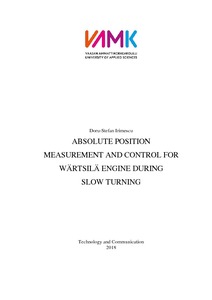Absolute position measurement and control for Wärtsilä engine during slow turning
Irimescu, Doru-Stefan (2018)
Irimescu, Doru-Stefan
Vaasan ammattikorkeakoulu
2018
All rights reserved
Julkaisun pysyvä osoite on
https://urn.fi/URN:NBN:fi:amk-201804094300
https://urn.fi/URN:NBN:fi:amk-201804094300
Tiivistelmä
The thesis work was carried out for Wärtsilä Finland Oy’s Engine Performance and Control department of the Marine Solutions division. The paper studied the implementation of the absolute position measurement and control of Wärtsilä’s engine crank angle during the slow turning procedure. The topic came out as an endeavor to improve the functionality of Wärtsilä’s engine control system, as at the moment of its proposal the crank angle had remained unknown during the entire slow turning sequence. The aim of the thesis was to implement a solution that would facilitate the precise adjustment of the engine position after the slow turning had proceeded.
Slow turning is a marine engine procedure during which the engine is being rotated at low speeds, in order to check the presence of water in the cylinders, as this can lead to hydrostatic locking, and thus cause severe damages during normal, high-speed operation. Given the fact that the tachometers used by the Wärtsilä engine systems at the outset of this study were of inductive nature, it was not possible to monitor rotational velocities below 100 rotations per minute. This meant that not only the engine stopped at an unknown position after slow turning, but also that, in the case that maintenance needed to be effectuated, manual engine positioning was required.
Research was conducted with the aim of investigating the current system, and finding its limitations. In addition, the necessary work for implementing, testing and documenting an improved alternative was performed.
Slow turning is a marine engine procedure during which the engine is being rotated at low speeds, in order to check the presence of water in the cylinders, as this can lead to hydrostatic locking, and thus cause severe damages during normal, high-speed operation. Given the fact that the tachometers used by the Wärtsilä engine systems at the outset of this study were of inductive nature, it was not possible to monitor rotational velocities below 100 rotations per minute. This meant that not only the engine stopped at an unknown position after slow turning, but also that, in the case that maintenance needed to be effectuated, manual engine positioning was required.
Research was conducted with the aim of investigating the current system, and finding its limitations. In addition, the necessary work for implementing, testing and documenting an improved alternative was performed.
